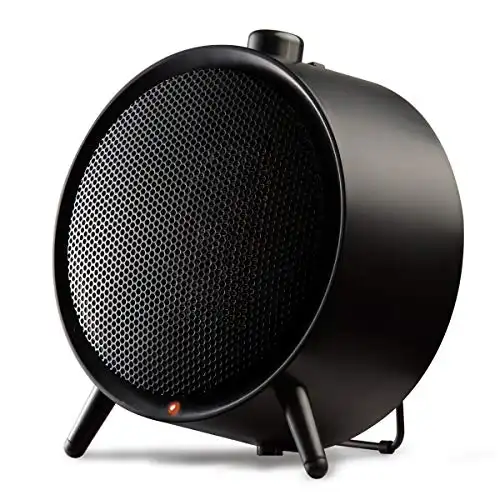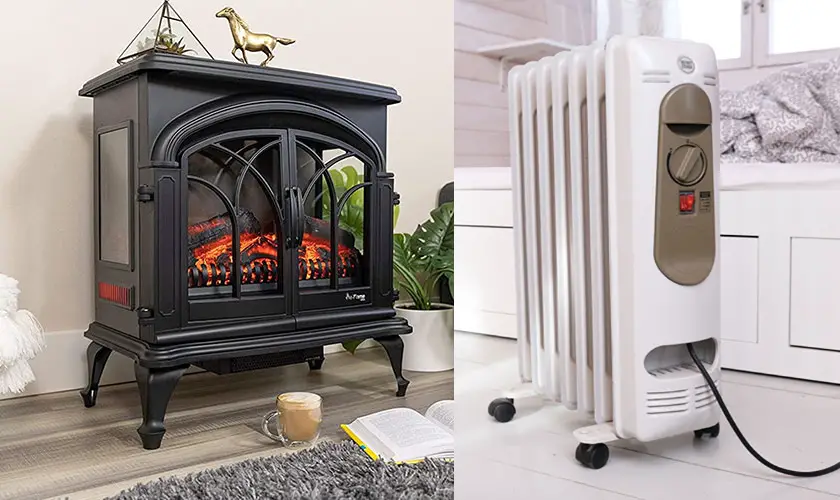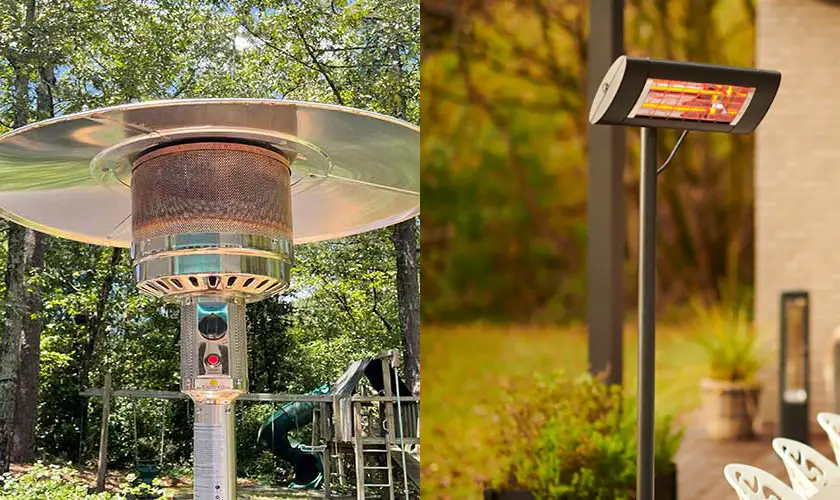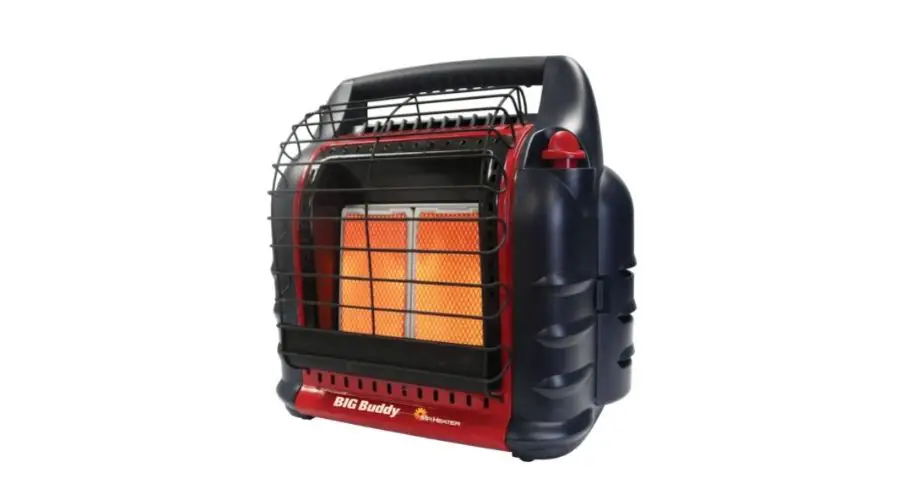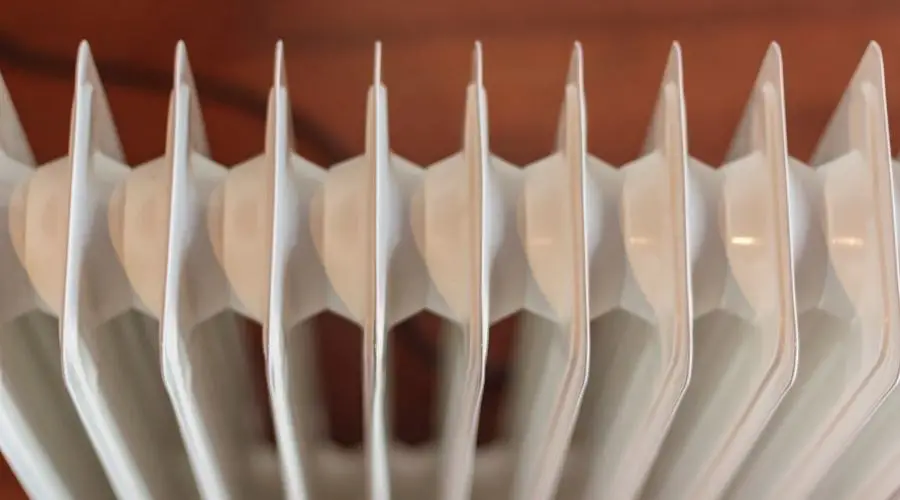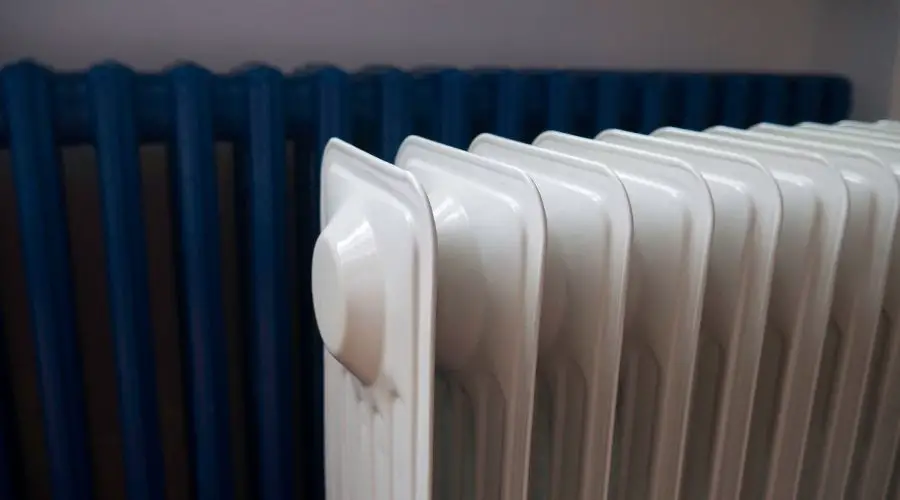Consider purchasing a portable ceramic heater to keep warm to reduce your winter electricity bill. You might find it too expensive to keep your centralized heat on during these times.
You can save money by only heating the rooms you use, such as your living room or office. Some space heaters are expensive. One of the main questions today is whether a ceramic heater is energy-efficient.
Ceramic heaters are usually cheaper to buy and use less energy. But, it can still be costly to omit electricity. They are also one of the better alternatives to your centralized heat. When choosing a ceramic heater, consider bonus features that can save you money.
In this article, we will answer your questions about ceramic heaters. This article will give examples of the best ceramic heaters you can buy. It will also summarize their features.
Is A Ceramic Heater Energy-Efficient?
Often, small ceramic heaters can move from one room to another. Some space heaters, like infrared heater or oil-filled heaters, use less energy than others.
So, small spaces suit many ceramic space heaters. If you have bigger rooms, you need to think about using baseboard heating, a stove, or a fireplace for heat.
Ceramic heaters are safe. This is because the elements do not overheat and remain cool to the touch. A more controlled exterior decreases the likelihood of burns or accidental fires.
Ceramic heaters can save energy and money with timers and automatic shut-off. Ceramic heaters are a great value and energy saver, particularly if you need to heat a small region.
To save money on electricity, consider buying a ceramic space heater with an adjustable thermostat and the convenience of a remote control, enabling you to regulate the temperature settings without the need for extension cords.
These will have either 2 or 3 settings, depending on the model. These settings are generally high, low, and eco (economic).
Eco is the setting you want most when saving yourself money. When you use the eco setting, your heater will turn off. It will turn back on once the room temperature drops to 79 degrees Fahrenheit. This happens after it turns off at 85 degrees Fahrenheit.

What Is The Advantage Of A Ceramic Heater?
Ceramic heaters produce heat by passing electricity through ceramic plates. As the plates heat up, the aluminum baffles do as well. A fan blows the hot air out of the baffles and into the room.
- Ceramic heaters are great because they give off heat without being too hot or dangerous. Ceramic heaters are safer because they surround the heating elements with ceramic parts. This prevents sparks or other safety hazards if the heating elements fail.
- These small but mighty heaters are great for offices or dens. They also work well in colder areas, providing extra warmth.
- You can also use ceramic heaters in front of windows to reduce condensation. This helps warm the whole room in winter.
- Ceramic heaters often have two or three temperature options, allowing you to adjust the heat. If you want to replace your main heat source or warm a small room, this option is affordable and great.
How Long Do Ceramic Heaters Last?
When looking for heaters for you and your family, longevity is one thing you might consider the most. The longer your heater of choice lasts, the more money it will save you in the long run. When you buy a heater, you usually hope it will save you money on electricity.
When it comes to ceramic heaters, they can last anywhere from 2 to 6+ years. If you have the misfortune of buying a faulty heater, you can expect your heater not to last longer than two years.
But, suppose you maintain your heater and store it. In that case, your ceramic heater can last a very long time, saving you plenty of money on your electricity.

Can I Leave My Ceramic Heater On Overnight?
Although you can leave space heaters on overnight, keeping them supervised is best. If malfunctions happen, you want to be aware of them as soon as possible.
That being said, you can keep yourself warm by running ceramic heaters overnight. If this is one of your primary concerns, there are features you need to have to keep the heater on overnight.
1. Auto-Off Timer
The first safety feature you need your heater to have is an auto-off timer. This timer will allow you to set a specific time when your heater will shut off. The ceramic space heater will turn off itself after a set time.
For instance, if your heater has been on for 12 hours, the heater will shut off. Use this as a safety measure for your space heaters to avoid overheating. It will be a backup if you forget to turn off the heater.
2. Shut-Off Switch
If you plan to use your ceramic space heater overnight, ensure it has more safety features. This could be an overheating shut-off switch. This feature is self-explanatory. If the unit gets too hot, the heater will turn off to prevent fires.
3. Cool To Touch Exterior
If you have pets or young children in your room, find a cool cover with a switch to prevent tipping. The case feels cool, so you and your pets won’t burn yourselves if you touch it.
4. Tip-Over Protection
If the appliance gets knocked over, the tip-over safety switch will turn off. This will help prevent the heater from burning the floor surface if it lands face down.
Most, if not all, ceramic heaters come with these safety features. Before buying, double-check to ensure safety and comfort for you and your family.

How Much Does It Cost To Run A 1500 Watt Ceramic Heater?
If your electricity bill is too high, you should focus on saving energy. Using space heaters instead of central heatingz can be a good option if you use them.
To determine the running cost of your space heaters, use this simple calculation.
Most electric and gas companies will charge anywhere from 0.15 cents to 0.33 cents per kilowatt per hour. Kilowatts are the larger measurement of watts.
1000 watts equals 1 kilowatt. That said, most space heaters run anywhere at 600, 900, or 1500 watts, so in kilowatts, that is 0.75 to 1.5 kilowatts.
Say your heater runs at 1500 or 1.5 kilowatts, and you run your space heater for at least 10 hours a day. Divide 1500 by 1000 to get 1.5.
Assume the heater is 1500 watts or 1.5 kilowatts, and you use it at least 10 hours a day. Divide 1500 by 1000 to get 1.5. Then add 1.5 by 10 to get 15 kilowatt-hours. So, at $0.15 per kW, the heater would cost about $2.25 to run 10 hours daily. (electricity use calculator)
To calculate your total cost, apply the same steps used for each heater to all of them. Using 1 or 2 personal space heater is generally cheaper than using your centralized heater all day.
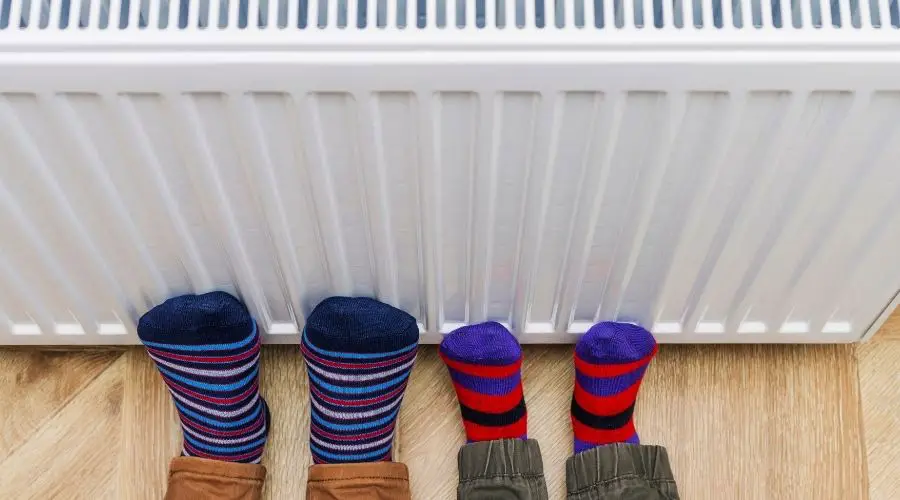
Which Type Of Heater Is Cheapest to Run?
The heater you choose affects how cheap it is to run. There are other things to think about, too. Where you plan to use your new heater affects how long it needs to work. This is also where most customers consider the heater size they need.
The size is generally determined by the BTU or wattage rating and the room’s square footage. Now that you know where to put the heater and how efficient it is, think about how often you’ll use it.
Seasonal Heaters
When deciding on a heater, consider whether you only need it in winter or all year. People take out heaters in the winter and put them away in the spring.
This group offers affordable compact electric space heaters for small to medium-sized rooms. Seasonal heaters are usually inexpensive and electric in design.
Some homes can use seasonal heaters, but a permanent effective heating system saves more money in the long term. These units are bigger and cost more, but they can heat a larger area with propane or natural gas.
Portable Electric and propane Gas Heaters
When discussing the cheapest heater to run, we must look at all the different heaters. This article will only discuss the different kinds of portable heaters on the market to keep it short. This comes down to portable electric and portable gas heaters.
Most people buy portable electric heaters when they want a space heater for their entire house. Electric space heaters are simple to use. Plug them in, and they heat up pretty well. They also cool down when you need to put them away again.
Of course, they’re inexpensive, which most people look for! But, this does not imply that the operating expenses are low.
Let’s look at different portable electric heaters and their pros and cons.
1. Oil-filled Radiators
Oil-filled radiators are very efficient because they can hold heat well. They are also among the most affordable.
2. Convector Or Convection Heaters
These heaters warm the air nearby and create a cycle of hot and cold air to heat the whole room. They take a little longer to complete the task, but the result is well worth it.
3. Halogen Heaters
Frugal people like halogen heaters because they’re cheap to use and heat up.
4. Fan Heaters
These heaters heat up and are very lightweight, making them easy to move around. They’re perfect for heating a specific area. What’s the catch? You will have to deal with the sound of the fan!
How efficient are they? Very much so! All-electric heaters are 100% efficient because they turn all their energy into heat. Portable space heaters with thermostat controls are efficient. You can set them off when the room reaches the desired temperature.
If your heater doesn’t have a thermostat, you can use a plug-in thermostat or timer instead.
Electric heaters are the most efficient and most straightforward option to install and use. They are also less expensive and safer than gas heaters.
Electric heaters may seem cheaper to buy, but they cost more to use than gas heaters. This is because the higher their wattage, the higher the cost. You must exercise caution if you have small children or pets nearby because it is portable.
5. Portable Gas Heaters
You can carry portable gas heaters and use them anywhere in your home. These heaters come in two main types:
- Radiant gas heater: These space heaters are ideal for spot heating specific areas.
- A portable gas stove is like a mini fireplace but harder to move. It’s cozy and looks nice.
In general, gas heaters are less efficient than electric heaters. This is because they tend to leak heat and fumes. Electric heaters are better for the environment than gas heaters because they don’t burn fossil fuels. Electric heaters can run on renewable electricity.
Gas heaters cost less than electric ones since gas is cheaper than electricity. Despite the reduced operational energy costs, there are a few disadvantages. Gas heaters tend to be very heavy and difficult to maneuver.
They can also be unstable, so keep an eye on them if you have young children or pets. To let the water vapor escape, keep the windows open or ventilate the space. Oh yes, please don’t forget to load up on gas canisters less you find yourself without heat.
Pros & Cons Of Ceramic Heaters
If you want ceramic heaters for your home, there are still things to consider.
| ADVANTAGES | DISADVANTAGES |
|---|---|
| Compact in size | Not a larger space heater (best for smaller-sized rooms) |
| Lightweight | Ceramic heaters that do not have a fan heat a room slowly |
| Heat up quickly | To provide heat, most types must run continuously (and consume electrical energy) |
| It takes some time for ceramic plates to cool off (heat still radiates after being turned off) | Physical objects can hamper heat transmission |
| Heat can have the ability to oscillate | |
| Some come with a wireless thermostat. | |
| Housing that is cool to the touch | |
| Moving around is easy. |
What Is The Best Ceramic Heater to Buy?
When it comes to looking for the best ceramic heater for you, there are a few that we will list here. Most stores offer and rate these ceramic heaters.
Honeywell’s UberHeat Ceramic Personal Heater is a 1500-watt, adjustable thermostat and tip-over switch personal heater.
The UberHeat features overheat protection, cool touch housing, and an overheat safety shut-off. It also features an easy carry handle for portability from room to room or office to cubicle!
Honeywell’s UberHeat is the perfect personal heater for any home or office space.
The Honeywell UberHeat Ceramic Heater tower heater is simple to use. It has a programmable thermostat and easy digital controls. It has two heat settings: high (1500 watts of power) and low (750 watts). The slim design allows it to fit in any room without taking up much space while still being powerful.
This Honeywell model is also not lacking in safety features. It has a sturdy base, oscillation, and a cool-touch plastic enclosure. This heater has a safety feature that stops it from getting too hot. It also has an extra safety measure called an overheat sensor. Along with those features, this model has a 360º tip-over protection switch.
The Lasko 755320 has two very quiet highs and lows, running at 1,500-watt Heater and 750 watts. Because of its extensive oscillation, this heater distributes warm air throughout the room. The digital display lets you adjust the heater’s 1500-watt ceramic heating element. You can select Fahrenheit or Celsius temperatures using a simple digital thermometer.
The Lasko heater can be plugged into a wall outlet. It has a remote control for adjusting the temperature, setting the timer, and controlling the oscillation speed. It uses efficient power.
The space heater has overheat protection to prevent overheating when left on for a long time. The heating stays cool even after hours of use because of its cool-touch exterior. The model has tip-over protection. It shuts off if there’s an accident.
The Portable Electric Space Heater provides two heat levels: one at 1500 watts and one at 750 watts. It produces both a heater and a fan so that you can use it in winter AND summer. Once it tilts, adjust the thermostat to a longer time and activate the auto-off button.
This radiator is easy to carry around and not so bulky to sit in the corner of a room. Finally, this small electric heater can warm a room up to 200 square feet. It also has improved flame resistance due to its upgraded ABS material.
Portable Ceramic Heater FAQs
Below are answers to your most frequently asked questions (FAQs).
Are portable ceramic heaters any good?
People like portable ceramic heaters because they heat, have safety guidelines, are easy to move, and are affordable. They also have adjustable thermostats and operate. But, they are best for small to medium-sized rooms and still consume electricity.
Do ceramic heaters use a lot of electricity?
Ceramic heaters use electricity based on how powerful and long they’re on. Multiply the power rating by hours to calculate consumption (e.g., 1500W x 3h = 4.5kWh). Multiply by your electricity cost to find the expense (e.g., $0.12/kWh → $0.54 for 3 hours). While efficient, prolonged use can increase costs.
Is it safe to leave a ceramic heater on all night?
If you want to leave a ceramic heater running all night, ensure it has safety features. These can include a switch that turns it off if it falls over and protection against getting too hot. Put it on a sturdy surface with room for air to flow, and use a thermostat to avoid getting too hot.
Which is better, infrared or ceramic heaters?
Infrared heaters heat specific areas but may not heat rooms. They operate but can be a safety risk due to hot coils. Ceramic heaters heat rooms. They have lower surface temperatures for safety. They are also portable. While they take longer to warm a room, they’re suitable for whole-room heating.
Are Ceramic Heaters Energy Efficient?
Ceramic heaters are considered to be energy-efficient space heater due to their quick heat-up time and ability to retain heat. They use a ceramic element as a heat source, allowing efficient heat transfer and reducing energy waste.
What are the types of space heaters?
Different types of space heaters serve specific purposes:
Ceramic: Portable with fan-driven ceramic heat.
Infrared: Direct heat, efficient heat for objects and people.
Oil-Filled: Consistent, prolonged warmth using heated oil.
Micathermic: Quick, even heat through radiant heater and convection.
Fan-Forced: Versatile air heating with a fan element.
Baseboard: Convection heating for larger rooms.
Wall: Mounted heaters for targeted room heating.
Propane/Kerosene: Portable fuel-powered heaters for outdoor
Electric Fireplace: Visual ambiance with electric heating.
Pedestal/Tower: Oscillating, tall heaters for broad area warmth.
Garage/Workshop: Rugged heaters for substantial heat in specific spaces.
Final Thoughts
We hope this article has answered all your questions about ceramic heaters, including the ideal period of time for operating personal heaters. We strive to help you find the perfect heater for your home, showcasing some good ceramic space heaters.


